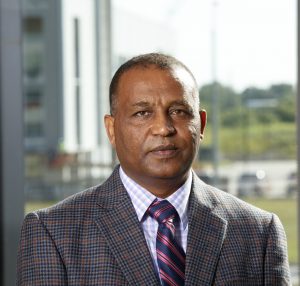Water touches everything. Every aspect of life relies on it, whether it’s nourishing the human body, sanitation or the production of everyday items. Water leaves a footprint larger than most things on the planet.
Dr. Mesfin Mekonnen, an assistant professor in civil, construction and environmental engineering at The University of Alabama, studies the water footprint and how it directly and indirectly affects the world.
“The global water footprint, sustainability of production and consumption, water scarcity and linking how consumers impact water systems in faraway places is the core of my research area,” Mekonnen said.
Mekonnen became interested in environmental sciences while he was living, working and earning bachelor’s degrees in economics and chemical engineering in his hometown of Addis Ababa, Ethiopia. While working in the country’s Ministry of Mines and Energy, he became familiar with environmental impact assessment studies and witnessed industries routing untreated wastewater into the rivers.
Mekonnen received a Joint Japan/World Bank fellowship to study environmental science and technology at the UNESCO-IHE Institute for Infrastructure, Water and Environment in the Netherlands. It was here that he became familiar with the concept of the water footprint and began developing a footprint calculator for his master’s thesis. His work caught the attention of Dr. Arjen Hoekstra, who offered him the chance to earn his Ph.D.
“The water footprint was at its early stage of development, making it more attractive to make a significant contribution,” Mekonnen said.
Working as a postdoctoral researcher after receiving his Ph.D. in water engineering and management from the University of Twente in the Netherlands, Mekonnen gained more experience in water footprint assessment, modeling water use in crop and animal production, water productivity assessment and assessing global water scarcity. Later, he worked as a research assistant professor and postdoctoral associate at the Daugherty Water for Food Global Institute at the University of Nebraska.
Seeking a permanent position where he could expand his water research, Mekonnen applied for a faculty position at UA in 2020.
“During my visit here, the leadership and the faculty made it clear that water was one of the priority areas of the University,” he said. “My own background check confirmed that.”
Mekonnen was soon hired by UA’s College of Engineering, and his talents were encouraged and supported by the Alabama Water Institute Executive Director Scott Rayder and AWI Global Water Security Initiative Director Michael Gremillion.
“Mesfin’s research will enable our society to better appreciate water’s impacts on all aspects of our livelihoods as water-related crises will become more widespread in the coming decades,” said Gremillion.
Thanks to funding from the AWI and GWSI, one of Mekonnen’s current projects is the Global Hydrology and Water Footprint Assessment Tool.
“The goal is to develop a dynamic tool to be used by the center and others interested in finding answers to some of their questions,” he said.
According to Mekonnen, some questions are related to what extent the production of a certain product is going to deplete rivers and affect ecosystems, which product will be exposed to water-related risk, and what the water footprint of a certain product is and how can it be reduced. He also said a multinational company in the U.S. may want to know if the materials it sources from other countries will be exposed to disruption due to water scarcity.
“The Global Hydrology and Water Footprint Assessment Tool project will help me develop my research as it will generate valuable data for other researchers, industries, environmental groups and policy makers,” said Mekonnen. “In addition, I can use some of the modeling exercises to integrate in my course and teach students.”
Mekonnen will be collaborating with UA’s Center for Complex Hydrosystems Research, Center for Water Quality Research and Center for Sustainable Infrastructure. He will also be developing and submitting a CAREER proposal in the area of nutritional sustainability of food systems to the National Science Foundation.
“The food system is one of the main sources of environmental impact: water pollution and depletion, greenhouse gas emissions, nutrient pollution and land use change,” he said. “The effects are not localized as consumers in the U.S. may have a large impact in faraway places, and consumers in other countries may also contribute to depletions here, such as the High Plains aquifer in the western U.S.”
Although the idea is still in the early stages of development, Mekonnen would like to create a telecoupled framework to link the food system with diverse effects across different spatial levels and learn how to ensure that the provision of required nutrition does not lead to major environmental impacts.
Mekonnen said he believes the results of these projects will have far-reaching benefits.
“There are global tools, but they are all static and provide data that is not up-to-date,” he said. “At the end of the project, I hope we will have a dynamic tool that will provide the latest data and have the capability to do further analysis.”

